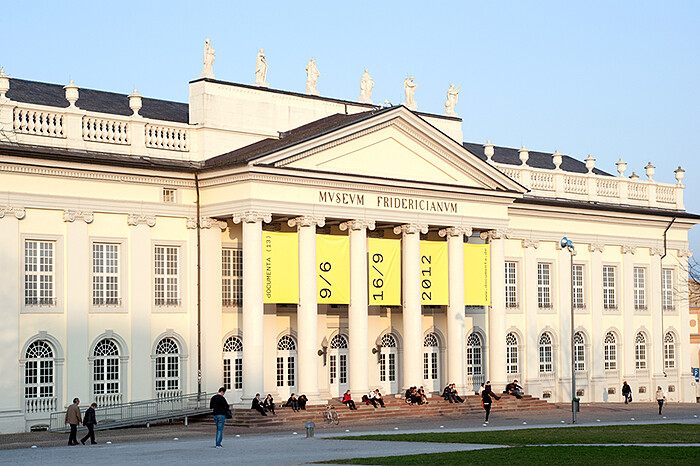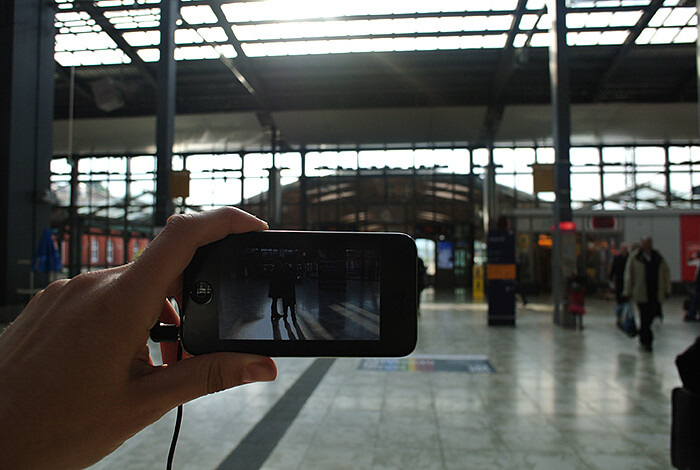Postcard 1: The Format
Dear reader, I hope these lines find you well, wherever you are right now. I have decided to address you through postcards, as to remain on Documenta 13’s wavelength. In fact, those who have followed the development of this Documenta may have noticed that the format of the letter was, from an early stage, the preferred means of communication. It was used during the preparation of the show, to give insight into the working processes and to outline some key issues of the exhibition (signed by the Artistic Director, Carolyn Christov-Bakargiev and originally distributed as Letter to a friend, it was subsequently published as Number 003 in the series: Documenta 13: 100 Notes – 100 Thoughts).
Now, here in Kassel, the total bareness of the first rooms of the canonical core, the Kunsthalle Fridericianum, is broken by the display of Kai Althoff’s letter to Christov-Bakargiev explaining his decision not to take part in the exhibition (“life” was more important)—although a work of Althoff’s is, despite this, still featured in the Rotunda. In the same building, on the first floor, visitors are presented with two walls covered with letters from official organizations that once more address the Artistic Director, this time to answer her proposal of nominating the earth’s atmosphere for UNESCO’s World Heritage List (a project of the American artist Amy Balkin). The epic, yet failed, attempt to transport El Chaco meteorite to Kassel, undertaken by the Argentinean duo Guillermo Faivovich and Nicolás Goldberg, is also widely documented by various exchanges. Then, we must not forget the 16 (sixteen!) pages of the press release, that, even if it is presented as an essay, begins: “The dance was very frenetic, lively, rattling, clanging, rolling, contorted, and lasted for a long time.”
Postcard 2: The Dance
It seems somehow problematic to make reference to the exhibition-making process, something that usually stays forever behind closed doors to the visitor. Despite this, what seems to have remained from that energetic rave is the incessant, hectic, incontrollable, and almost perverse character of the whole project. Beyond the exhibition sites, there are endless things to see, to experiment, to reflect upon. So many stages, micro- and macro-museum-like environments, archives, usual and unusual locations, and so many formats, states of mind, hopes, dreams, situations. Not even Catherine David’s 1997 Documenta 10—which accompanied a world quickly changing with transformations in global communication systems—seemed to have such an intense program of events. For example, on the opening day, at exactly the same time, one was faced with the choice of going to Raimundas Malašauskas’s Hypnotic Show at the Karlsaue Park, or heading to the Kaskade Cinema to assist in Jérôme Bel’s Disabled Theatre, or to see Tarek Atoui’s Metastable Circuit 1 at the Orangerie, to follow Rossella Biscotti’s Trial at the Neue Galerie, or to be at the Hauptbahnhof North Wing to see Michael Portnoy’s 27 Gnosis. Choice is the keyword for such an overloaded menu. Still, in the train station, Janet Cardiff and George Bures Miller lead you to meander in a mesmerizing time-overlapping experience that updates the artist’s famous walks with the introduction of image-based documentation. Moving deeper into the north wing of the train station, one happens upon an installation in a house by Haris Epaminonda and Daniel Gustav Cramer offering up an equally inebriating experience through arrangements of images, texts, letters, and found objects, mostly from domestic contexts, combined with multiple projections in a chiaroscuro labyrinth of rooms. This is surely one of Epaminonda’s most complex projects up until now, and it presents itself as one of the many museum-like configurations to be seen in Kassel.
Postcard 3: The Museums
If The Book of Books is the title of the main catalogue of the exhibition, then “The Museum of Museums” should, perhaps, title the dense and tight Rotunda area that surprisingly appears to the visitor after the perplexity felt by crossing the naked entry rooms of the Fridericianum. Before getting there, Ryan Gander’s breeze, I Need Some Meaning I Can Memorise (The Invisible Pull) (2012)—a light wind that caresses one’s skin and hair—and Ceal Floyer’s audio piece, a melodious promise, repeated to exhaustion, of “So I’ll just keep on… till I get it right” (‘Til I Get It Right, 2005), hail the most attentive spectators.
The emotive, yet dry conceptualism, as introductory praise for retreat and delicacy, is suddenly broken by the paraphernalia announced behind the glass wrapping of the Rotunda. Here is the brain of the show, which assumes a clear anthropological, variegated configuration. The Rotunda presents a collection of inputs, stimuli, and background references, ranging, for example, from Giorgio Morandi’s six marvelous still life paintings to the minute Bronze Age, female stone statuettes from Central Asia (“Bactrian princesses”) and to the dimly illuminated cabinet of Man Ray’s objects and images, such as a series of his paradoxical metronomes Indestructible Objects (or Object to Be Destroyed) from the 1920s.
Thought and form, hand and brain, history and time, politics and pleasure, research and improvisation: all of these comprised the gigantic organism that is this Documenta 13, and largely celebrated by the large amount of micro-museums, from Pedro Reyes’s Museum of Hypothetical Lifetimes (2011), an ode to human nature and social structure, to Kader Attia’s The Repair from Occident to Extra-Occidental Cultures (2012)—a horrifying yet astonishing research project on the impact and effects of francophone colonialism; to Michael Rakowitz’s cabinets of destroyed or lost books, and many, many others.
I feel I should send you more postcards, dear reader, from the Karlsaue Park, where a profusion of huts and other structures punctuate the green; from the Orangerie, the Neue Galerie or from the many non-conventional venues. But the show has just begun, and the offer of events and artworks is so extensive and overwhelming that I dare not cause you any anxiety for all that could be seen. Just leave the screen, and join me, here or elsewhere, for this ambitious world of worlds.








